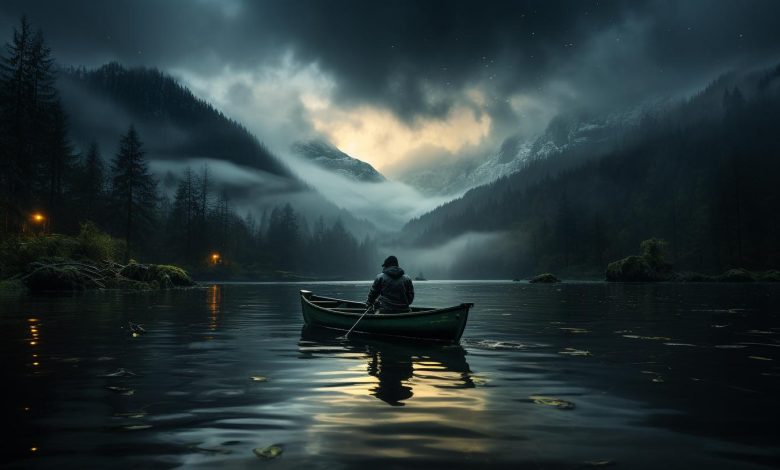Walleye Fishing At Night: Tips For Successful After-Dark Angling

Are you ready to take your walleye fishing to the next level? Fishing for this popular game fish can be challenging enough during the day, but have you considered trying your luck at night?
Walleye are known to be more active and easier to catch after dark, making nighttime angling a great option for any serious fisherman. However, it’s important to understand their behavior, use the right equipment, and take necessary safety precautions in order to make your after-dark fishing trip a success.
In this article, we’ll provide you with expert tips and techniques for catching walleye at night. From understanding their nocturnal habits and selecting the best gear, to staying safe on the water and using proven tactics for landing trophy-sized fish, we’ve got everything you need to know about walleye fishing at night.
So grab your rod and reel, pack some snacks and beverages, and get ready for an unforgettable experience under the stars!
Understand Walleye Behavior at Night
It’s crucial to understand how these fish behave during the evening hours if you want to increase your chances of a catch.
Walleye, like many other fish species, are known for their nocturnal feeding habits. They are more active at night and tend to feed in shallow waters where they can find prey such as crayfish and small fish.
In addition to their feeding habits, walleye have also adapted well to low light conditions. Their eyes have a layer of tissue called the tapetum lucidum that reflects light back through the retina, enhancing their ability to see in the dark.
Understanding these behaviors is essential when planning your next nighttime walleye fishing trip.
Now let’s talk about choosing the right equipment for successful after-dark angling.
Choose the Right Equipment
When it comes to night fishing for walleye, having the right equipment is essential.
To maximize your chances of success, you’ll need to select a fishing rod and reel that are both sturdy and sensitive enough to detect subtle bites in low light conditions.
It’s also important to choose the right line and leader based on factors such as water clarity and the size of the fish you’re targeting.
Essential gear for night fishing
To have a great time catching those elusive walleyes at night, you’ll need to make sure you’ve got all the essential gear packed up and ready to go.
Night fishing benefits from having gear that provides comfort, as well as visibility. First, invest in a good headlamp or flashlight with red or green light options so that you don’t scare off the fish. Additionally, bring along warm clothing and extra layers since temperatures tend to dip at night. Don’t forget bug spray too! Mosquitoes can be an absolute nuisance and ruin your fishing experience.
Secondly, choose comfortable fishing chairs or boat seats to keep you relaxed while waiting for a bite. A cooler packed with snacks and drinks will also ensure that hunger and thirst don’t distract from your fishing goals.
Lastly, it’s important to have reliable communication devices such as cell phones or two-way radios in case of emergencies. Now that you’re equipped with all the necessary gear for night fishing success, let’s talk about tips for selecting the best fishing rod and reel.
As mentioned earlier, choosing the right equipment is crucial for successful night fishing. When it comes to selecting a fishing rod and reel, there are several factors to consider which we’ll explore in the next section.
Tips for selecting the best fishing rod and reel
You’ll want to make sure you’ve got the right gear for your nocturnal angling adventure, which includes selecting the best reel and rod that meets your specific needs. When it comes to selecting a fishing reel, consider its size, weight, and line capacity. You’ll want a durable and reliable model that can handle the strain of reeling in big catches at night.
Factors to consider when choosing fishing gear include the type of fish you’re targeting, the depth of water you’ll be fishing in, and your personal preferences as an angler. As for selecting a fishing rod, choose one with enough power to handle the weight of your lure or bait and the strength of your target species. Keep in mind that a longer rod will provide greater casting distance while shorter rods are better suited for tight spaces.
With these tips in mind, you’re well on your way to setting up a successful night-time walleye fishing excursion! And speaking of success, let’s move on to choosing the right line and leader for catching those elusive walleye.
Choosing the right line and leader
Finding the perfect line and leader is like unlocking a hidden treasure for your nocturnal adventure, adding another layer of excitement to your angling experience.
When choosing the right line and leader, it’s important to consider the materials that will best suit your needs. Fluorocarbon is a popular choice for its invisibility underwater, while monofilament offers flexibility for casting. Meanwhile, braided lines provide excellent sensitivity and strength.
Once you’ve chosen the perfect material, knot tying becomes crucial in ensuring your line and leader are secure during battle with a walleye. You can choose from several knots such as the Palomar knot or improved clinch knot depending on your preference.
Additionally, managing your line and leader effectively is key in avoiding tangles or breakage during an intense fight with a fish. Make sure to adjust for water conditions such as depth and current to ensure optimal performance before heading out into the night waters.
As you prepare to head out onto the dark waters in search of walleye, it’s important to also keep safety precautions in mind.
Safety Precautions
When it comes to night fishing for walleye, safety should always be your top priority. Proper lighting is crucial for both seeing where you’re going and avoiding potential hazards in the water.
You’ll also need to know how to navigate in the dark, whether that means using a GPS or simply paying close attention to your surroundings.
Finally, it’s important to prepare for emergencies by carrying essential supplies like first aid kits and emergency flares. By taking these precautions, you can enjoy a successful night on the water without putting yourself or others at risk.
Importance of proper lighting
Make sure you’ve got the right kind of light to illuminate your boat and the water around you, so you can see what’s happening both above and below the surface.
The importance of lighting for walleye fishing cannot be stressed enough, as it allows you to spot fish in the dark waters and avoid obstacles that might be hazardous. When choosing the right lighting equipment, there are a few things to consider:
1. Brightness: You need lights that are bright enough to illuminate your surroundings but not so bright as to scare away fish.
2. Color temperature: Choose lights with a color temperature between 4000K-5000K, which mimics daylight and does not attract insects.
3. Durability: Look for lights that are waterproof, shockproof, and built for outdoor use.
4. Power source: Decide whether you want battery-powered or wired lights based on your needs.
Having proper lighting is essential for successful walleye fishing at night. By ensuring that your boat is well-lit, you’ll be able to navigate through dark waters safely while keeping an eye out for any potential catches lurking beneath the surface.
Now that you know how important proper lighting is, let’s move on to some tips for navigating in the dark without compromising safety or efficiency.
Tips for navigating in the dark
Navigating in the dark can be an adventure, so let’s explore some helpful tricks to keep you safe and confident on your nighttime boat rides.
As you prepare for a successful night of walleye fishing, it’s important to adjust to low light conditions. One key technique is to use your other senses besides sight when navigating through the water. Listen closely for sounds such as waves hitting rocks or buoys that can indicate potential hazards. Also, pay attention to the direction of the wind since it can help guide you towards or away from shorelines.
Another tip is to familiarize yourself with your boat and its equipment before heading out at night. Practice launching and docking during daylight hours so that you’re comfortable with the process when visibility is limited. Additionally, make sure all lights on your boat are functioning properly and consider adding extra lighting such as LED strips along walkways or under gunwales for better visibility.
With these night fishing techniques in mind, let’s now discuss how to prepare for emergencies without interrupting your fishing trip.
As you hit the water after dark, it’s crucial to have proper emergency gear on board in case something unexpected happens.
Preparing for emergencies
In order to be fully prepared for any emergency that may arise on your nighttime boat ride, it’s important to take note of the fact that nearly 80% of boating accidents occur due to operator error. Having proper emergency gear on board can greatly reduce the risk. Make sure you have an emergency kit that includes a first aid kit, flares, a whistle or horn, and a fire extinguisher.
Additionally, having a communication plan in place with someone on shore or another nearby boat can ensure that help is readily available if needed. When packing your emergency kit, think about what you might need in case of an injury or accident while out on the water. Include bandages, gauze pads, antiseptic wipes, and pain relievers. And don’t forget to pack extra batteries for flashlights or other electronic devices you may need in an emergency situation.
With these preparations made, you can now focus on techniques for successful night fishing without worry about unexpected events getting in the way.
Techniques for Successful Night Fishing
As you approach the water’s edge, your eyes adjust to the darkness and you can hear the distinct sound of water lapping against the shore.
Nighttime fishing offers several advantages, such as less competition for spots and less boat traffic. However, it’s important to avoid common mistakes like using too much light or making too much noise that could scare away potential catches.
To increase your chances of success at night fishing, try out some new techniques like slow retrieves or using glow-in-the-dark lures.
Slowly dragging your lure across the bottom of the lake can attract walleye in search of an easy meal. Additionally, glow-in-the-dark lures can be highly effective at night as they emit a bright light that attracts fish from a distance.
With these tips in mind, you’ll be well on your way to a successful night fishing trip without having to rely on pure luck alone.
Tips for a Successful Night Fishing Trip
When planning your night fishing trip, it’s important to consider both the location and timing. Choose a spot where you know fish are likely to be active at night and plan your outing during peak feeding times.
However, don’t expect instant results – successful night fishing requires patience and persistence.
Planning your trip and location
Make sure you’ve scouted out the perfect spot for your evening adventure and have planned accordingly to make the most of your nocturnal expedition. Nighttime fishing can be tricky, so preparation is key.
Here are a few things to keep in mind when planning your trip:
– Researching Conditions: Before heading out, it’s important to check weather and water conditions. Make sure you know what kind of fish you’re looking for and what type of bait they prefer.
– Finding Hotspots: Look for areas where walleye tend to congregate at night, such as drop-offs or weed edges. It’s also worth asking local fishermen or checking online forums for tips on popular nighttime spots.
– Planning for Comfort: Dress appropriately for the weather, but also bring extra layers as temperatures can drop quickly at night. Don’t forget bug spray and a headlamp or flashlight.
– Staying Alert: Fishing at night requires heightened awareness since visibility is limited. Bring snacks and caffeine if needed to help stay awake.
Once you’ve planned out all these details, you’ll be well-prepared for a successful night of walleye fishing! Now let’s talk about the best times for night fishing.
Best times for night fishing
Now that you’ve planned your trip and location for walleye fishing at night, it’s important to know the best times to fish. The two main factors to consider are moon phases and water temperature fluctuations.
When it comes to moon phases, the best time for walleye fishing is during a new or full moon. These phases provide more light at night, which helps attract baitfish and, in turn, attracts walleye. Additionally, when the moon is full, there’s more current, which can also stimulate feeding behavior in walleye.
Understanding water temperature fluctuations is also crucial for successful night fishing. Walleye are cold-water fish and tend to feed more actively when the water temperature drops. Therefore, targeting areas with cooler water temperatures, such as near inflows or deep holes, can increase your chances of catching walleye.
It’s important to keep in mind that even with this knowledge, catching walleye at night requires patience and persistence.
Staying patient and persistent
Don’t get discouraged if you don’t catch anything right away, remember that patience is a virtue and good things come to those who wait – so keep at it!
Night fishing for walleye requires a lot of persistence since these fish are more active during the night. They like to move around and feed in the dark, which means that you might need to spend several hours on the water before you have any luck.
Staying patient and maintaining focus is key when night fishing. It can be tempting to give up early, especially if you’re not used to fishing in low light conditions. However, keep in mind that walleye are nocturnal creatures who prefer hunting in the darkness. So it’s essential to stay alert and focused as long as possible because your chances of catching them increase with time.
Remember, patience pays off when night fishing for walleye!
Conclusion
Congratulations, you’re now armed with the knowledge and tips needed to successfully catch walleye at night! Understanding their behavior is key, so take note of their feeding patterns and preferred habitats. Make sure you have the right equipment, such as a strong rod and reel with a sensitive tip and a good quality fishing line. Safety should always be a top priority, so bring along appropriate personal flotation devices and lighting.
When it comes to techniques for successful night fishing, consider using lures that emit light or sound to attract walleye. Try varying your retrieval speed and experiment with different depths until you find what works best. And don’t forget about live bait options like minnows or leeches.
As an interesting statistic to add some sophistication to this topic, did you know that according to a survey by the U.S. Fish and Wildlife Service, over 10 million people participate in freshwater fishing each year?
With these tips in mind, join the millions who enjoy the thrill of catching walleye at night – happy fishing!


